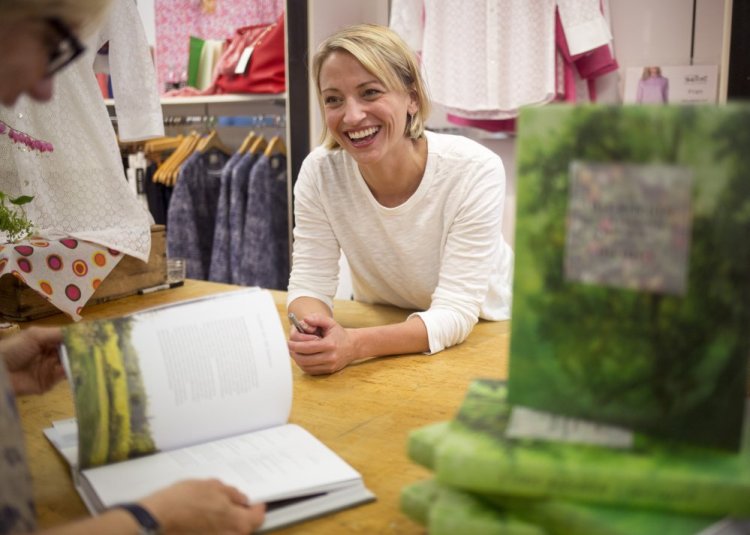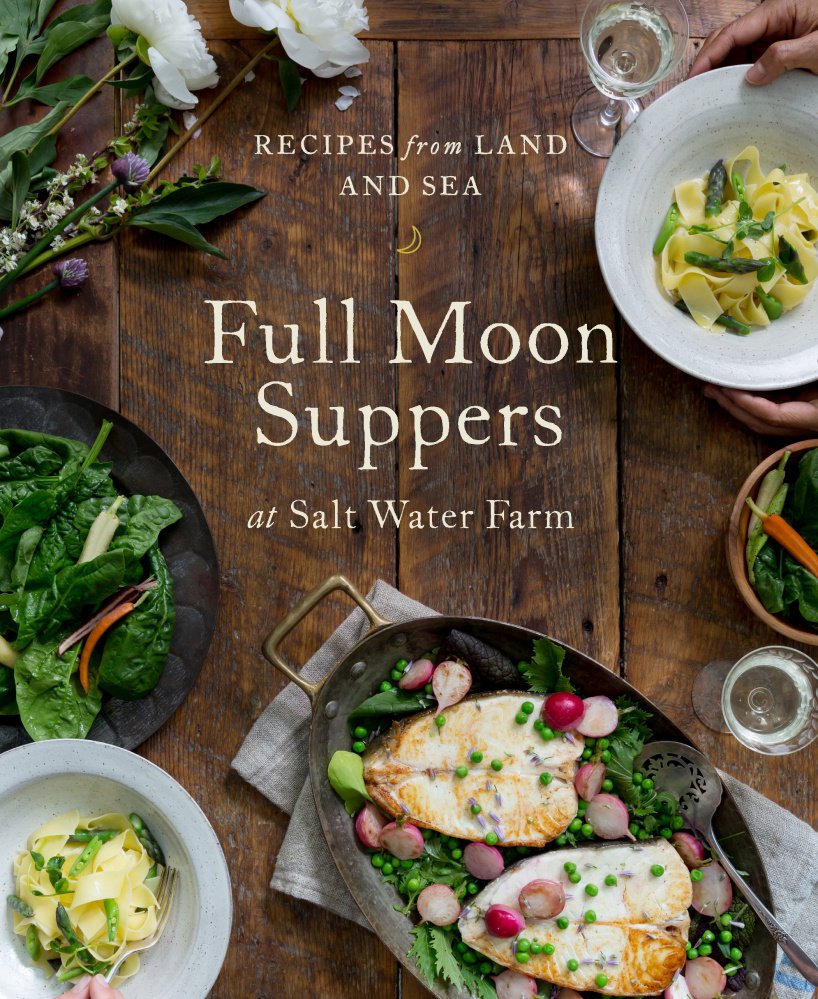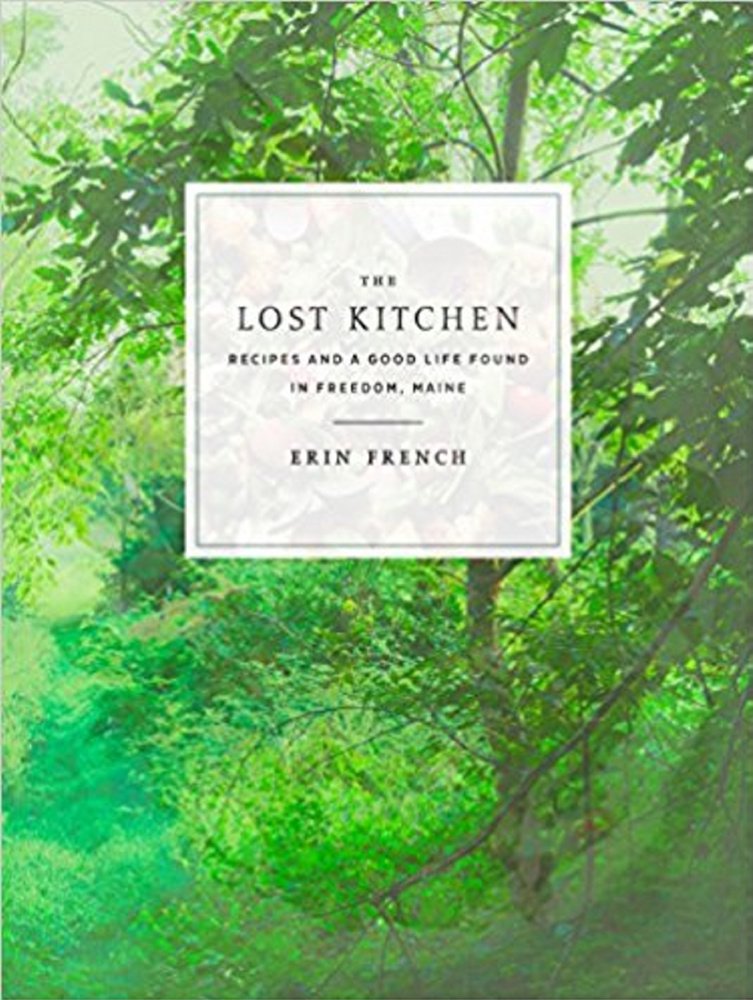The movie industry has a term for it: “twin films.” It describes when two uncannily similar movies – from different directors and different studios – come out at about the same time, say “Capote” (2005), with the late great Philip Seymour Hoffman, and “Infamous” (2006), also about novelist Truman Capote. It happens with musical acts – think ‘NSync and Backstreet Boys. With fashion collections. With zombie TV shows.
And with cookbooks.
Two beautiful new Maine cookbooks arrived on my desk within days of each other this May: “The Lost Kitchen: Recipes and a Good Life Found in Freedom, Maine” by Erin French, chef of the nearly-impossible-to-get-into Lost Kitchen restaurant, and “Full Moon Suppers at Salt Water Farm: Recipes from Land and Sea” by Annemarie Ahearn, who owns Salt Water Farm cooking school in nearby Lincolnville. Her classes sell out, too, though not as quickly, as do her monthly Full Moon Suppers, upon which she based her cookbook.
Freedom and Lincolnville are just 30 miles apart. French and Ahearn are just one year apart: French is 36, Ahearn 35. People who eat at Lost Kitchen enjoy a set multi-course menu served in a beautifully restored 1834 gristmill, and people who eat a Full Moon Supper enjoy a set multi-course menu served on a single rustic farm table overlooking Penobscot Bay – both experiences that diners have described as “magical.” Both women live and breathe and cook the seasonal, farm-to-table ethos so ascendant in American cuisine today, and their cookbooks – both first cookbooks – champion the same.
As I flip through their pages, sometimes I forget which one I am looking at.
CUISINE OF PERSON AND PLACE
New York Times restaurant critic Pete Wells recently wrote smartly and provocatively about the restaurant scene in Sydney, Australia: “Most travelers – not just restaurant critics – imagine the food in distant lands will be completely different from what they eat back home… But if you go to restaurants run by inventive young chefs… you often find yourself eating on a kind of global continuum. The ingredients are almost always local, but, more often than not, what the chefs do with them is informed by a running conversation the restaurant is having with restaurants in other cities around the world.”
If, as he argues, chefs around the world pick up similar ideas in part from Instagram, food-focused travel and apprenticeships at the same handful of influential restaurants, is it any wonder that two chefs who live within easy biking distance of one another would produce like books?
The similarities pile up. Both books are arranged by season, although “Lost Kitchen” opens in spring while “Full Moon Suppers” starts in the dead of winter. Both conceive of the seasons poetically. Spring in “Lost Kitchen” is Shower, Buds & Blossoms. January in “Full Moon Suppers” is The Full Wolf Moon; each monthly dinner, Ahearn explains, perhaps a little earnestly, pays respect to “Native American symbolism, and they are a tribute to the creatures, the elements, and the conditions of the earth as we round the lunar cycle.” Back at the gristmill, winter is Flannel, Frost & Wood Smoke.
The prose, too, can be like reading in an echo chamber. Here is French, writing about winter: “Winter is the ultimate reminder to slow down and calm weary bones. The shortened daylight provokes a reason to hibernate – to go to bed a little earlier and sleep a little later, the labors of summer behind us.” Now listen to Ahearn on the same subject: “Those of us who make a living on the coast of Maine work tirelessly from May to October, so that come January, we can put our feet up by the fire with a glass of cider or bourbon and flip through a 600-page novel at leisure, guilt-free.”

Annemarie Ahearn cooks monthly Full Moon Suppers served on a single rustic farm table overlooking Penobscot Bay. Photo by Kristin Teig/Courtesy of Roost Books
The books share a handmade, artisanal aesthetic – though for my money “The Lost Kitchen” is prettier, with its modern rustic style; evocative photos of old Maine barns, lacy wildflowers, bucolic apple orchards and fire-lit shorelines; and all that vintage dishware. (Note to self: Find out where French goes flea market shopping.) Each book has a smattering of photos of the authors, looking attractive and woodsy chic. My guess is the publishers had a hand in this, too. The farming/foraging pastoral life sells, especially coming from oft-idealized states like “the way life should be” Maine.
Consumers today expect cookbooks to describe person and place, according to antiquarian cookbook expert Don Lindgren, of Rabelais in Biddeford, a perspective he appreciates.
“It’s a good moment for us to recognize the point of view of a particular person making recipes and to re-emphasize the place that the food comes from,” he said. “For decades, we ignored all that. And we’re in an age where we can get recipes off the Internet – recipes are just these sets of instructions that we can grab whenever we need them and make dinner. The idea that the author’s vision or personality is in books – I find that marvelous as a pure reminder that the recipes come from somewhere.”
COOK THE BOOKS
I guess I shouldn’t be surprised to find that the recipes run in parallel, too. Berry shortcake and brown bread are probably to be expected in any Maine cookbook that wears its regionalism on its sleeve, and perhaps Maple Ice Cream (“Full Moon Suppers”) and Maple and Candied Walnut Ice Cream Sundae (“Lost Kitchen”), too. But Fried Squash Blossoms? Ahearn’s are simply dipped plain in batter, French’s are stuffed with a cheese-herb mixture first. Where Ahearn adds lovage to her gin and tonic, French adds sea rose and cucumber to hers, and they both make elderflower simple syrups. Ahearn’s Celery Root Salad with Fennel and Apple corresponds with French’s Waldorf Salad with Apples, Fennel & Candied Walnuts, while the duck breasts, one with a pile of lentils and fried potatoes (French), the other with a pile of Jacob’s Cattle Beans and roast apples (Ahearn), look like kissing cousins (that Lapsang souchong tea brine for the duck in French’s book is calling my name). Both books offer recipes for tapenade and chicken liver mousse/pâté, too.
Since the cookbooks were getting along so well on the page, I decided to introduce them to one another at a mid-June dinner date. I compiled a menu of four dishes from both books, then invited eight guests, including three who’d had the good – no great – fortune of a meal (or two!) at the Lost Kitchen; none had (yet) taken a class or eaten under the moon with Ahearn. Although I had no views of Penobscot Bay to offer nor a lovely gristmill setting, I did my best to honor the spirit of both cookbooks by shopping at the farmers market. Armed with, in part, locally grown parsnips and potatoes, locally caught halibut, locally baked bread and herbs from my very own backyard, I spent a pleasant day in my kitchen (Ahearn: “There is no greater pleasure for a cook than devoting an entire day to the kitchen, uninterrupted”) making Spring Bread Salad with Asparagus, Radishes, Peas & Mint (“Lost Kitchen,” spring), Cast-Iron Halibut Steaks with Herbed Compound Butter, Radishes, Arugula, and Peas (“Full Moon Suppers,” June), Smashed Potatoes and Alfonso Olive Tapenade (“Full Moon Suppers,” May) and Parsnip Cake with Hazelnuts and Mascarpone (“Lost Kitchen,” spring).
To begin with the end – the cake was a big hit, although I not-so-privately wondered if it needed quite so much baking powder (or any), and I’m calling French out on her claim that she dreamed up parsnip cake herself (“It actually started out as carrot cake… but I wanted to put a twist on it. My mind went to spring-dug parsnips…”) (On another day, I made French’s Rhubarb Spoon Cake, and fell deeply and irretrievably in love.)
The potatoes were also crowd-pleasers, though I found I needed just half the amount of olive oil Ahearn asked for in the tapenade. My own favorite dish of the evening was the halibut, despite my anxiety about cooking fish to order for a crowd. That delicious compound butter – I had nearly twice what I needed, not a complaint – did double duty lavished on homemade bread that a guest had baked and contributed to dinner. He gets invited back.
The recipe for salad called for both asparagus and English peas. It was the end, or very near, of asparagus season, and I had no luck finding any at the Portland Farmers Market. As for the English peas, they were still weeks away, and I got profoundly skeptical looks from several farmers when I asked if the growing seasons ever coincide. In such a rigorously seasonal cookbook, perhaps they shouldn’t have been paired. But French gave me permission to experiment, so I took it:

The interior of the nearly-impossible-to-get-into Lost Kitchen restaurant, which made national news this spring when chef/owner Erin French, who takes reservations for the season one day a year, got 10,000 calls in 24 hours. Photo by Nicole Franzen/Courtesy of Clarkson Potter
“…where you don’t have exactly the constituents I’ve named, go forth and experiment,” she writes. “Learn to trust your instincts, discover through play, and if all else fails, remember that there are few ails that butter and salt can’t cure.” (Amen to that.)
I went forth with thin slices of roasted rhubarb from my garden (very sour!) in place of the asparagus and fava beans (shame-faced admission: from the supermarket) in place of the peas. For good measure, I threw in a few sliced strawberries. Guest commentary: “very unique and tasty, which don’t always go hand in hand.”

A Full Moon Supper presented by Annemarie Ahearn, who owns the Salt Water Farm cooking school in Lincolnville. Courtesy of Salt Water Farm
I don’t want to overstate my case about these cookbooks. I recognize the indisputable talent and self-evident passion that went into each. I liked both books – with “Lost Supper” having the edge over “Full Moon,” for me. The women are both friends and professional acquaintances, according to Ahearn. I recognize the differences between the books, too: “Full Moon Suppers” emphasizes how to be a good host – chill your glassware, set the table ahead of time, etc. – and the book has a more formal, teacherly tone. French’s recipes seem more distilled, a little homier and more imaginative, too, dishes like Pork Burgers with Grilled Peaches, Bacon and Blue Cheese; Ramp & Fiddlehead Fried Rice; A Stew of Moose with Parsley Dumplings; and Parsnip Needhams. (I am getting hungry typing out this sentence.)
Over dinner, my guests played well together, though several were strangers to each other. The food played well together, too, as if it sensed its kinship. The last guests left at close to midnight, and I fell into bed almost before I shut the door behind them. The next morning, as I cleaned up the dinner party detritus, filling the dishwasher, scrubbing the pots and laundering the cloth napkins, I picked up “Lost Kitchen” and “Full Moon Suppers” from the counter where I’d been cooking from them, now speckled with strawberry juice, butter and Macerated Shallot Vinaigrette (“Lost Kitchen”), and I lodged them with my other cookbooks. They stand there now, cozily cheek by jowl.
CAST-IRON HALIBUT STEAKS WITH HERBED COMPOUND BUTTER, RADISHES, ARUGULA AND PEAS
From “Full Moon Suppers at Salt Water Farm” by Annemarie Ahearn.
Serves 8
FOR THE COMPOUND BUTTER:
16 tablespoons (2 sticks) unsalted butter, softened
2 tablespoons minced chives
1 tablespoon minced sorrel
1 tablespoon minced thyme
1 tablespoon minced parsley
1 teaspoon kosher salt
Sea salt for sprinkling

FOR THE HALIBUT:
1 bunch radishes, tops removed
7 tablespoons butter
2 cups shelled English peas
2 large (or 4 small) halibut steaks (21/2 to 3 pounds total), on the bone
Freshly ground pepper
2 cups loosely packed arugula
1 squeeze of lemon juice
To make the compound butter, in a medium bowl gently mix butter, herbs, and kosher salt until blended. Press the mixture into a small crock and sprinkle with sea salt. Store in the fridge for use within the week or freeze for up to 6 months.
To make the halibut, slice radishes in half. In a medium pan, sauté them with 4 tablespoons of the butter and salt to taste over medium heat until they soften and begin to brown, about 5 minutes. Set aside.
Fill a medium saucepan with water, salt well, and bring to a boil. Pour peas into the water and cook on high heat until just tender, 2 to 3 minutes. While they cook, prepare an ice bath. With a slotted spoon, transfer the peas to the ice bath to shock them. Drain the peas.
Season halibut steaks with salt and pepper to taste. Melt the remaining 3 tablespoons of butter in a large cast-iron frying pan to coat the bottom. (For smaller steaks, you will need two pans, each with 1 1/2 tablespoons of butter.) Place the halibut steaks in the pan and cook over medium heat until they are golden brown on the bottom, about 8 minutes. Gently flip with a fish spatula and cook for an additional 4 to 5 minutes. Be careful not to overcook.
In a medium bowl, toss the argula with a pinch of sea salt and a squeeze of lemon. Arrange arugula on a platter. Take the halibut steaks and separate the meat from the bone, then divide each half steak into two portions. Each steak should yield four portions (or two portions from each small steak). Array the halibut steaks over the arugula and put pats of compound butter atop the hot fish. Pour the peas and radishes on top. Serve family-style.
SWEET PARSNIP CAKE WITH HAZELNUTS AND MASCARPONE
From “The Lost Kitchen. Recipes and a Good Life Found in Freedom, Maine.” By Erin French. French calls for 2 to 3 pounds parsnips to get 3 cups grated. A co-worker and I both had the same experience baking the cake – that it takes less, about a generous 1 pound. French calls for baking the cake in two 10-inch springform pans, which I suspect most home cooks won’t have. I baked it instead in two deep 9-inch pans, letting the cakes cool for 10 minutes in the pans before turning them out.

FOR THE CAKE:
Unsalted butter at room temperature, for the pan
2 cups all-purpose flour, plus more for the pan
2 teaspoons baking powder
2 teaspoons baking soda
2 teaspoons ground cinnamon
1 teaspoon salt
3/4 cup vegetable oil
4 large eggs
Grated zest and juice of 1 orange
3/4 cup granulated sugar
2/3 cup packed light brown sugar
3 cups grated raw parsnips
1 cup hazelnuts, toasted and roughly chopped
FOR THE FROSTING:
6 tablespoons (3/4 stick) unsalted butter, at room temperature
1/3 cup confectioners’ sugar, plus more for dusting
1 (8-ounce) container mascarpone
1/3 cup apricot jam
Make the cake: Preheat the oven to 375 degrees F. Butter two 10-inch springform pans, line the bottoms with parchment paper, and butter and flour the paper and sides, tapping out excess flour.
Combine the flour, baking powder, baking soda, cinnamon, and salt in a medium bowl.
In a stand mixer fitted with the paddle attachment, combine the vegetable oil, eggs, orange zest and juice, granulated sugar, and brown sugar. Mix on low until smooth. Add the dry ingredients and mix on low until just blended, scraping down the sides of the bowl with a spatula as needed. Add the parsnips and hazelnuts and mix until just incorporated.
Divide the batter between the two pans and bake until a cake tester or knife inserted in the center comes out clean, 20 to 25 minutes. Let the cakes cool in the pans on a wire rack.
Make the frosting: In a stand mixer fitted with the paddle attachment, beat the butter until fluffy and pale, about 1 minute. Add the mascarpone and jam and mix until just incorporated.
Remove the sides of the springform pans. Put one of the cakes upside down on a cake stand and remove the parchment paper. Spread the frosting over the top of the cake. Top with the second cake, remove the parchment, and dust with confectioners’ sugar. You can refrigerate any leftovers for a day or two, but they won’t last that long.
Send questions/comments to the editors.





